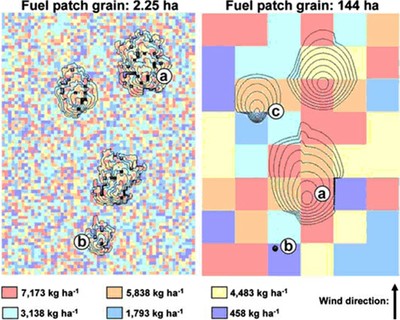Fire Behavior
Fire and grazing are ecological processes that frequently interact to modify landscape patterns of vegetation. This alteration of the vegetation can have significant impacts on fire behavior, from creating areas that will not burn, or producing locations that are extremely flammable and difficult to contain. Patch burning can also modify fire behavior, specifically when comparing the relationship between fire behavior and patch size of fuel heterogeneity.
The burn area (total acres), burn shape complexity (amount of fireline and shape of burn) and the proportion of area burnt by different fire types (headfire, backfire and flankfire) are all affected by the patch size (Figure 16). The area a fire can burn in a heterogeneous landscape is related to the fuel load present in the patch where ignition occurs. Burn shape complexity is greater in landscapes with small patch size than in landscapes with large patch size. The proportion of each fire type (backfire, flankfire and headfire) is similar among all landscapes regardless of patch size but the variance of burned area within each of the three fire types differs among size of patches.
This landscape fire simulation (Figure 16) shows that patch burning can be very beneficial for fuels reduction, wildfire suppression and making fire containment easier and safer. The positive advantages of patch burning can be accomplished through creation of blackened areas, grazing to reduce fuels loads, reducing the amount of fireline needed to be suppressed, and a decrease or removal of volatile fuels, such as eastern red cedar.
Figure 16. Illustration of landscape fuel maps with different patch sizes and different fuel loads (409lbs/ac to 6,405 lbs/ac). The concentric rings demonstrate fire perimeter at 30-min intervals for a 4 hour fire. All treatments of fuel patch size (5.5-ac and 356-ac are shown as examples here) had equal fuel loading when averaged across the entire landscape (3,405 lbs/ac). Fuel patch size and ignition point fuel load influence burn area, fire shape complexity, and proportion of headfire, backfire and flankfire. Note that each fire was simulated independently and that multiple fire perimeters on these maps are for demonstration only. (from Kerby et al. 2007).
Caption: The fire can be allowed to burn into the previous years patch (left) because fuel is insufficient to carry a fire. This feature of patch burning makes suppression of wildfires, along with implementing prescribed fires both safer and easier. Photo John R. Weir.


